University Assignment: Critical Review of Survey Method Selection
VerifiedAdded on 2020/03/23
|6
|1184
|66
Report
AI Summary
This report provides a critical review of survey methods used in marketing research, focusing on face-to-face, telephone, and mail surveys. The report discusses the strengths and weaknesses of each method, considering factors such as the ability to cover complex issues, resource requirements, response rates, cost-effectiveness, and the potential for bias. The face-to-face method is highlighted for its flexibility and probing capabilities, while telephone surveys are praised for their speed and cost-efficiency. Mail surveys are noted for their ability to reach dispersed populations at a reduced cost. The report concludes that the best survey method depends on the specific research objectives, the nature of the required information, and the available resources. The analysis emphasizes the importance of evaluating each method in the context of the research goals to make an informed selection. The report provides a comprehensive overview to assist researchers in choosing the most appropriate survey method for their needs.
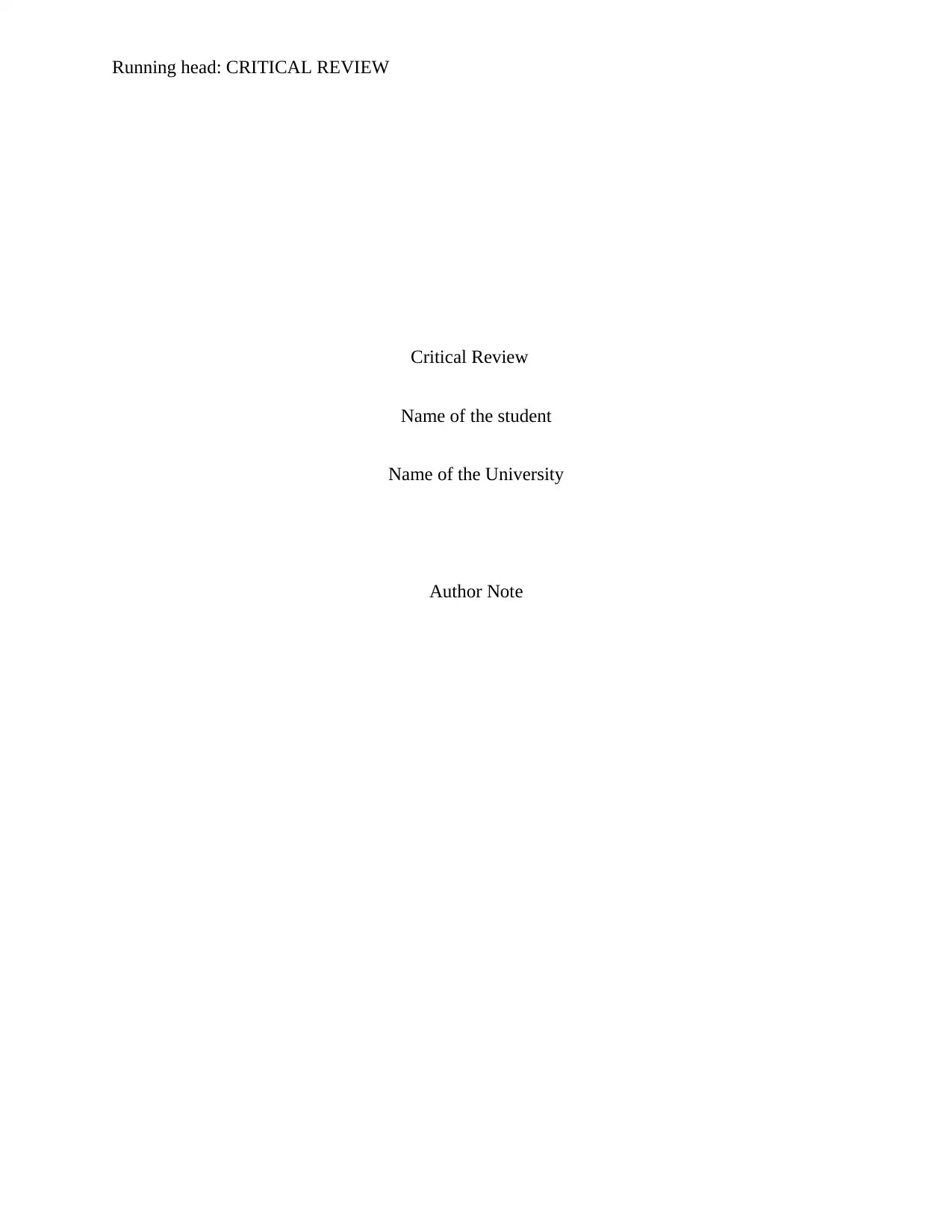
Running head: CRITICAL REVIEW
Critical Review
Name of the student
Name of the University
Author Note
Critical Review
Name of the student
Name of the University
Author Note
Paraphrase This Document
Need a fresh take? Get an instant paraphrase of this document with our AI Paraphraser
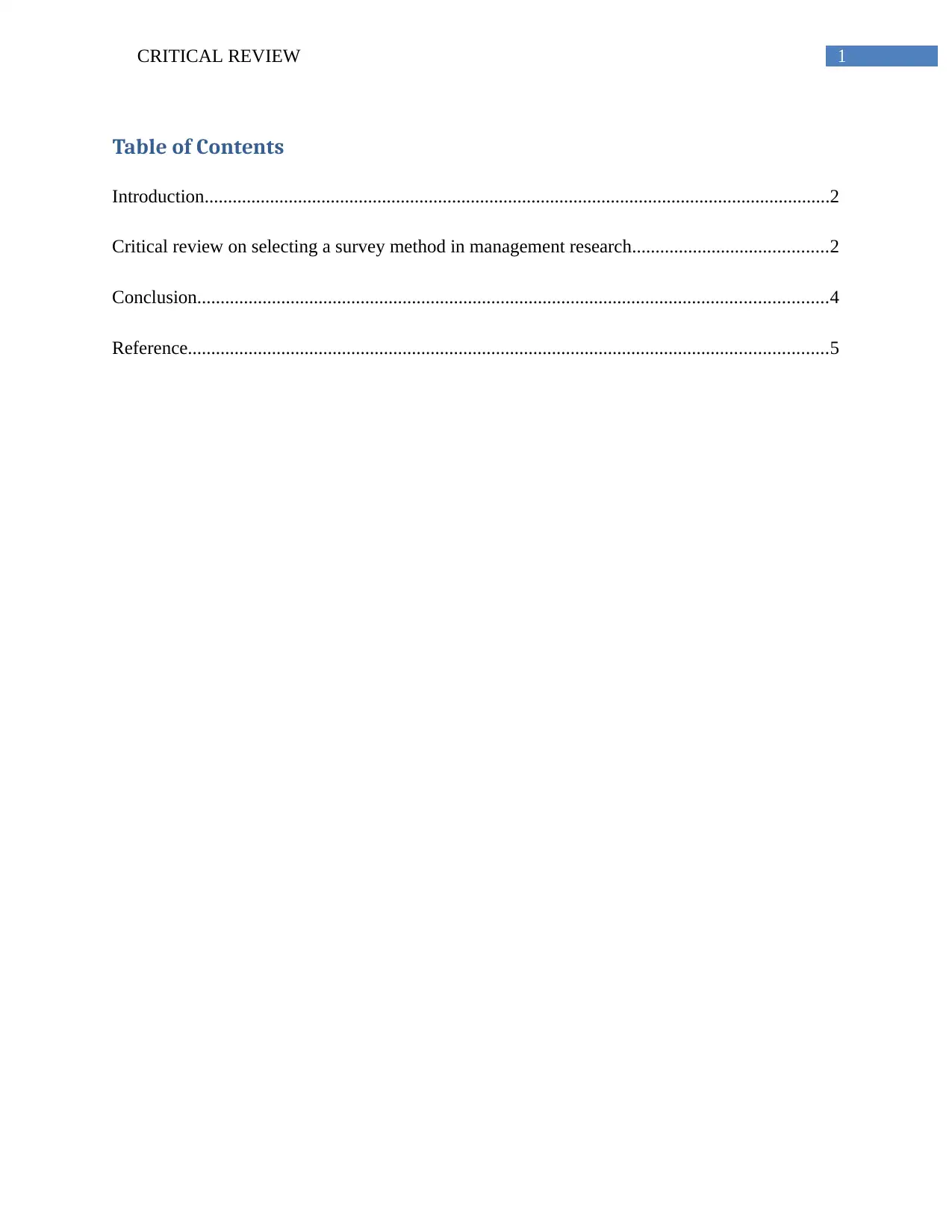
1CRITICAL REVIEW
Table of Contents
Introduction......................................................................................................................................2
Critical review on selecting a survey method in management research..........................................2
Conclusion.......................................................................................................................................4
Reference.........................................................................................................................................5
Table of Contents
Introduction......................................................................................................................................2
Critical review on selecting a survey method in management research..........................................2
Conclusion.......................................................................................................................................4
Reference.........................................................................................................................................5
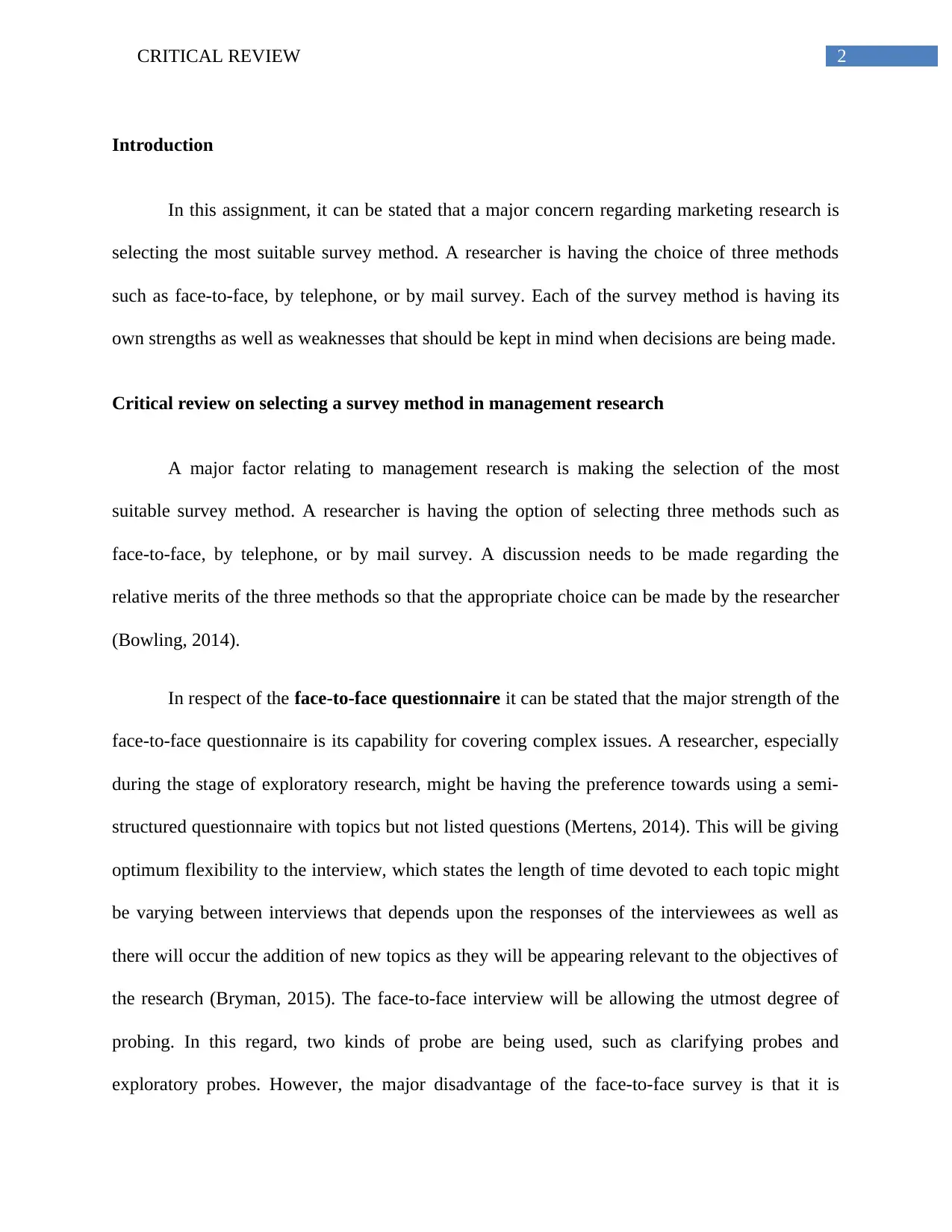
2CRITICAL REVIEW
Introduction
In this assignment, it can be stated that a major concern regarding marketing research is
selecting the most suitable survey method. A researcher is having the choice of three methods
such as face-to-face, by telephone, or by mail survey. Each of the survey method is having its
own strengths as well as weaknesses that should be kept in mind when decisions are being made.
Critical review on selecting a survey method in management research
A major factor relating to management research is making the selection of the most
suitable survey method. A researcher is having the option of selecting three methods such as
face-to-face, by telephone, or by mail survey. A discussion needs to be made regarding the
relative merits of the three methods so that the appropriate choice can be made by the researcher
(Bowling, 2014).
In respect of the face-to-face questionnaire it can be stated that the major strength of the
face-to-face questionnaire is its capability for covering complex issues. A researcher, especially
during the stage of exploratory research, might be having the preference towards using a semi-
structured questionnaire with topics but not listed questions (Mertens, 2014). This will be giving
optimum flexibility to the interview, which states the length of time devoted to each topic might
be varying between interviews that depends upon the responses of the interviewees as well as
there will occur the addition of new topics as they will be appearing relevant to the objectives of
the research (Bryman, 2015). The face-to-face interview will be allowing the utmost degree of
probing. In this regard, two kinds of probe are being used, such as clarifying probes and
exploratory probes. However, the major disadvantage of the face-to-face survey is that it is
Introduction
In this assignment, it can be stated that a major concern regarding marketing research is
selecting the most suitable survey method. A researcher is having the choice of three methods
such as face-to-face, by telephone, or by mail survey. Each of the survey method is having its
own strengths as well as weaknesses that should be kept in mind when decisions are being made.
Critical review on selecting a survey method in management research
A major factor relating to management research is making the selection of the most
suitable survey method. A researcher is having the option of selecting three methods such as
face-to-face, by telephone, or by mail survey. A discussion needs to be made regarding the
relative merits of the three methods so that the appropriate choice can be made by the researcher
(Bowling, 2014).
In respect of the face-to-face questionnaire it can be stated that the major strength of the
face-to-face questionnaire is its capability for covering complex issues. A researcher, especially
during the stage of exploratory research, might be having the preference towards using a semi-
structured questionnaire with topics but not listed questions (Mertens, 2014). This will be giving
optimum flexibility to the interview, which states the length of time devoted to each topic might
be varying between interviews that depends upon the responses of the interviewees as well as
there will occur the addition of new topics as they will be appearing relevant to the objectives of
the research (Bryman, 2015). The face-to-face interview will be allowing the utmost degree of
probing. In this regard, two kinds of probe are being used, such as clarifying probes and
exploratory probes. However, the major disadvantage of the face-to-face survey is that it is
⊘ This is a preview!⊘
Do you want full access?
Subscribe today to unlock all pages.

Trusted by 1+ million students worldwide
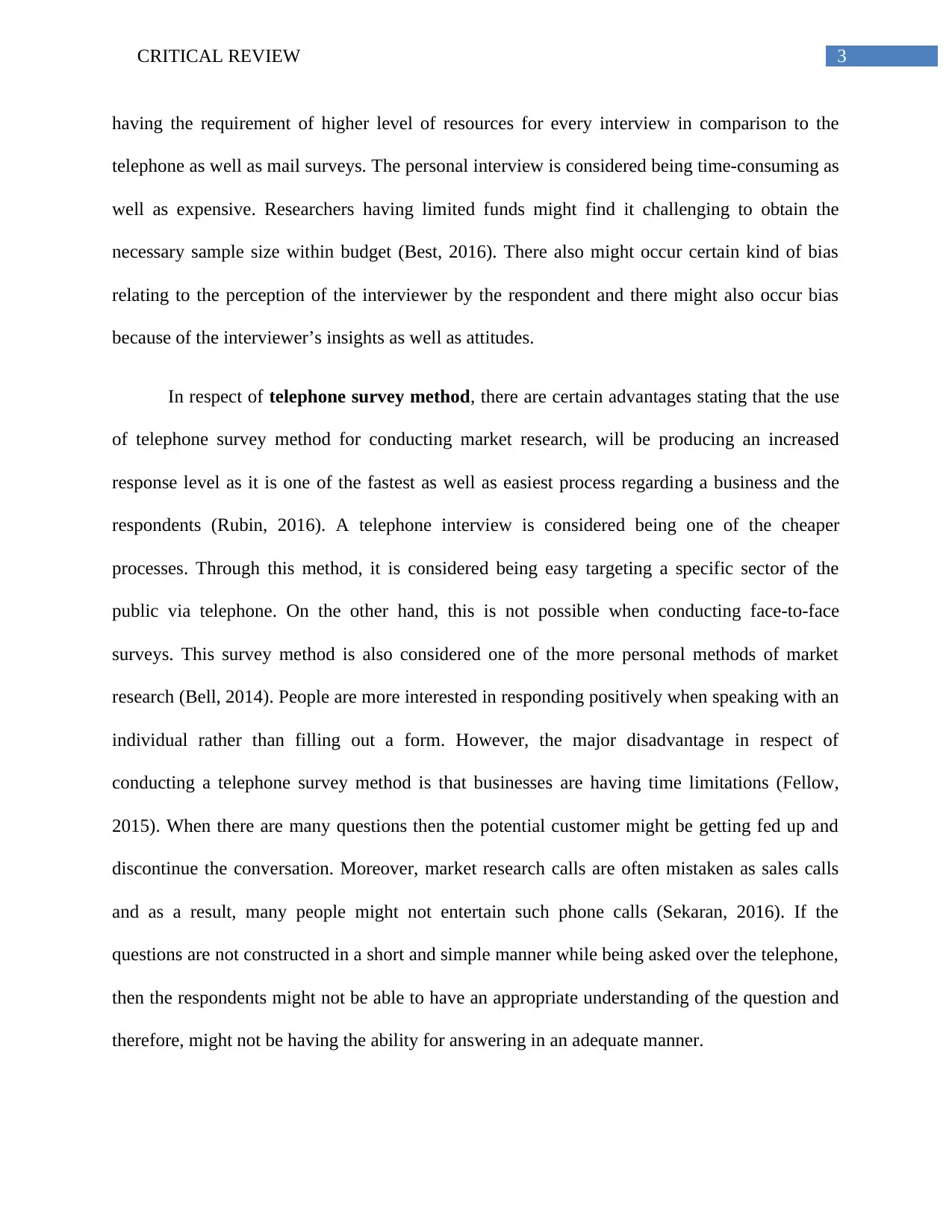
3CRITICAL REVIEW
having the requirement of higher level of resources for every interview in comparison to the
telephone as well as mail surveys. The personal interview is considered being time-consuming as
well as expensive. Researchers having limited funds might find it challenging to obtain the
necessary sample size within budget (Best, 2016). There also might occur certain kind of bias
relating to the perception of the interviewer by the respondent and there might also occur bias
because of the interviewer’s insights as well as attitudes.
In respect of telephone survey method, there are certain advantages stating that the use
of telephone survey method for conducting market research, will be producing an increased
response level as it is one of the fastest as well as easiest process regarding a business and the
respondents (Rubin, 2016). A telephone interview is considered being one of the cheaper
processes. Through this method, it is considered being easy targeting a specific sector of the
public via telephone. On the other hand, this is not possible when conducting face-to-face
surveys. This survey method is also considered one of the more personal methods of market
research (Bell, 2014). People are more interested in responding positively when speaking with an
individual rather than filling out a form. However, the major disadvantage in respect of
conducting a telephone survey method is that businesses are having time limitations (Fellow,
2015). When there are many questions then the potential customer might be getting fed up and
discontinue the conversation. Moreover, market research calls are often mistaken as sales calls
and as a result, many people might not entertain such phone calls (Sekaran, 2016). If the
questions are not constructed in a short and simple manner while being asked over the telephone,
then the respondents might not be able to have an appropriate understanding of the question and
therefore, might not be having the ability for answering in an adequate manner.
having the requirement of higher level of resources for every interview in comparison to the
telephone as well as mail surveys. The personal interview is considered being time-consuming as
well as expensive. Researchers having limited funds might find it challenging to obtain the
necessary sample size within budget (Best, 2016). There also might occur certain kind of bias
relating to the perception of the interviewer by the respondent and there might also occur bias
because of the interviewer’s insights as well as attitudes.
In respect of telephone survey method, there are certain advantages stating that the use
of telephone survey method for conducting market research, will be producing an increased
response level as it is one of the fastest as well as easiest process regarding a business and the
respondents (Rubin, 2016). A telephone interview is considered being one of the cheaper
processes. Through this method, it is considered being easy targeting a specific sector of the
public via telephone. On the other hand, this is not possible when conducting face-to-face
surveys. This survey method is also considered one of the more personal methods of market
research (Bell, 2014). People are more interested in responding positively when speaking with an
individual rather than filling out a form. However, the major disadvantage in respect of
conducting a telephone survey method is that businesses are having time limitations (Fellow,
2015). When there are many questions then the potential customer might be getting fed up and
discontinue the conversation. Moreover, market research calls are often mistaken as sales calls
and as a result, many people might not entertain such phone calls (Sekaran, 2016). If the
questions are not constructed in a short and simple manner while being asked over the telephone,
then the respondents might not be able to have an appropriate understanding of the question and
therefore, might not be having the ability for answering in an adequate manner.
Paraphrase This Document
Need a fresh take? Get an instant paraphrase of this document with our AI Paraphraser
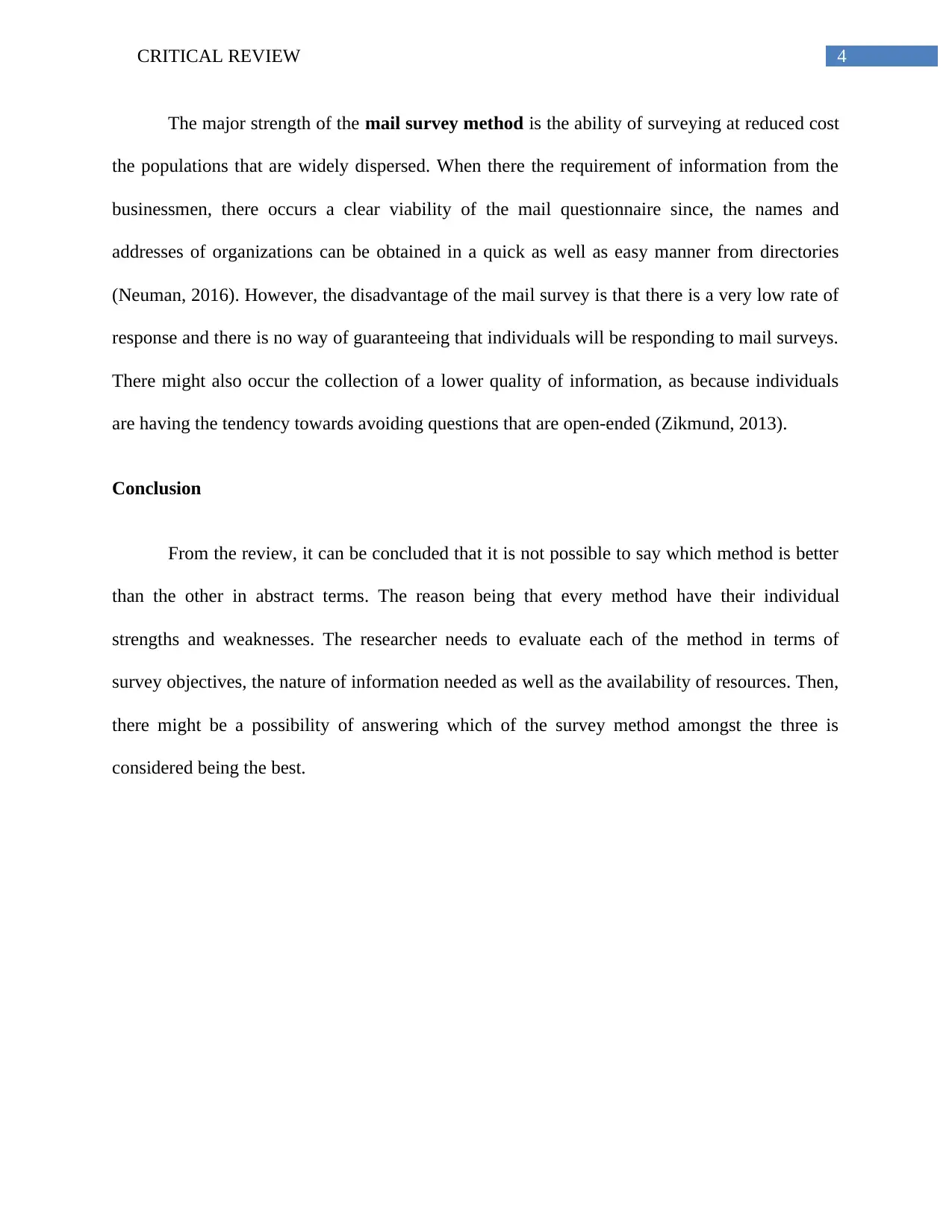
4CRITICAL REVIEW
The major strength of the mail survey method is the ability of surveying at reduced cost
the populations that are widely dispersed. When there the requirement of information from the
businessmen, there occurs a clear viability of the mail questionnaire since, the names and
addresses of organizations can be obtained in a quick as well as easy manner from directories
(Neuman, 2016). However, the disadvantage of the mail survey is that there is a very low rate of
response and there is no way of guaranteeing that individuals will be responding to mail surveys.
There might also occur the collection of a lower quality of information, as because individuals
are having the tendency towards avoiding questions that are open-ended (Zikmund, 2013).
Conclusion
From the review, it can be concluded that it is not possible to say which method is better
than the other in abstract terms. The reason being that every method have their individual
strengths and weaknesses. The researcher needs to evaluate each of the method in terms of
survey objectives, the nature of information needed as well as the availability of resources. Then,
there might be a possibility of answering which of the survey method amongst the three is
considered being the best.
The major strength of the mail survey method is the ability of surveying at reduced cost
the populations that are widely dispersed. When there the requirement of information from the
businessmen, there occurs a clear viability of the mail questionnaire since, the names and
addresses of organizations can be obtained in a quick as well as easy manner from directories
(Neuman, 2016). However, the disadvantage of the mail survey is that there is a very low rate of
response and there is no way of guaranteeing that individuals will be responding to mail surveys.
There might also occur the collection of a lower quality of information, as because individuals
are having the tendency towards avoiding questions that are open-ended (Zikmund, 2013).
Conclusion
From the review, it can be concluded that it is not possible to say which method is better
than the other in abstract terms. The reason being that every method have their individual
strengths and weaknesses. The researcher needs to evaluate each of the method in terms of
survey objectives, the nature of information needed as well as the availability of resources. Then,
there might be a possibility of answering which of the survey method amongst the three is
considered being the best.
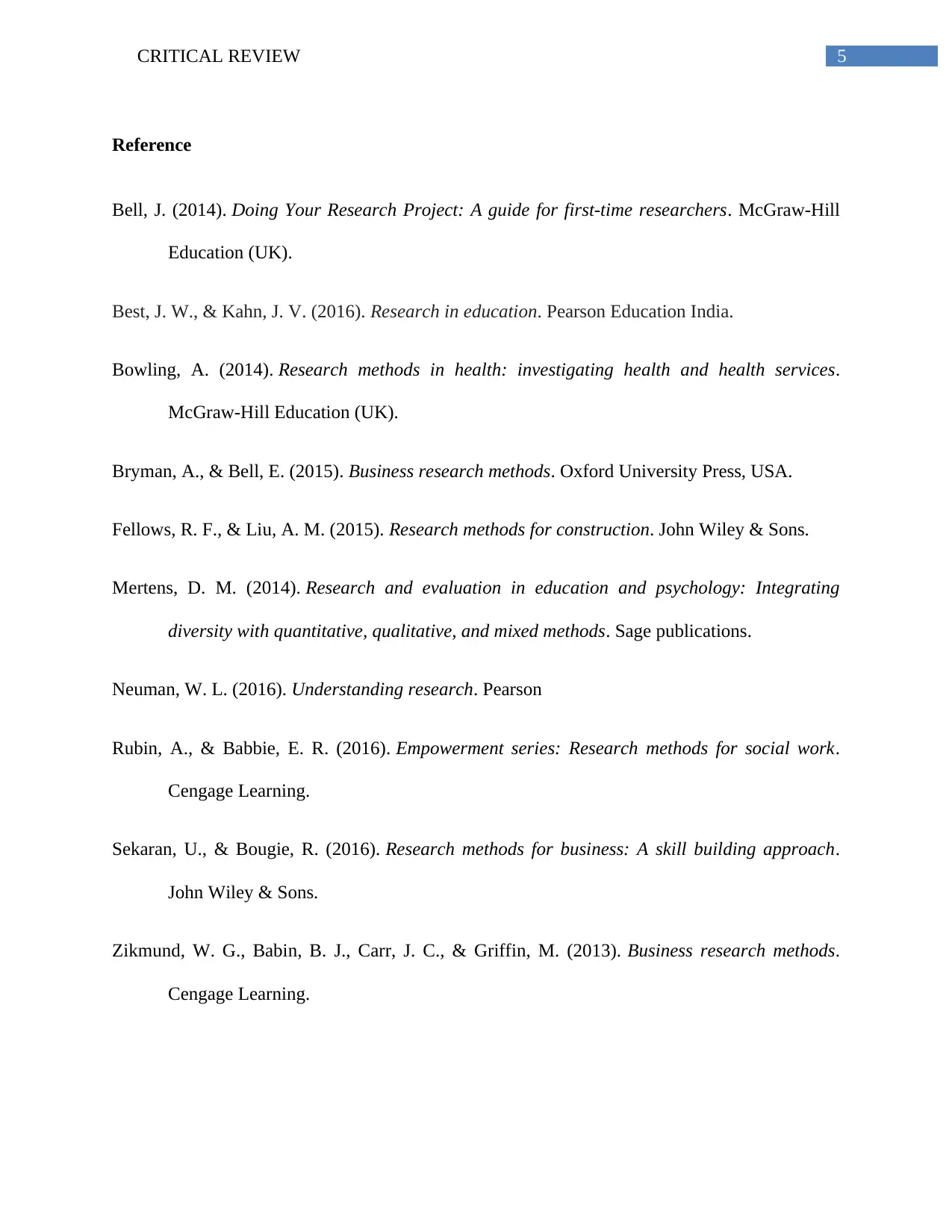
5CRITICAL REVIEW
Reference
Bell, J. (2014). Doing Your Research Project: A guide for first-time researchers. McGraw-Hill
Education (UK).
Best, J. W., & Kahn, J. V. (2016). Research in education. Pearson Education India.
Bowling, A. (2014). Research methods in health: investigating health and health services.
McGraw-Hill Education (UK).
Bryman, A., & Bell, E. (2015). Business research methods. Oxford University Press, USA.
Fellows, R. F., & Liu, A. M. (2015). Research methods for construction. John Wiley & Sons.
Mertens, D. M. (2014). Research and evaluation in education and psychology: Integrating
diversity with quantitative, qualitative, and mixed methods. Sage publications.
Neuman, W. L. (2016). Understanding research. Pearson
Rubin, A., & Babbie, E. R. (2016). Empowerment series: Research methods for social work.
Cengage Learning.
Sekaran, U., & Bougie, R. (2016). Research methods for business: A skill building approach.
John Wiley & Sons.
Zikmund, W. G., Babin, B. J., Carr, J. C., & Griffin, M. (2013). Business research methods.
Cengage Learning.
Reference
Bell, J. (2014). Doing Your Research Project: A guide for first-time researchers. McGraw-Hill
Education (UK).
Best, J. W., & Kahn, J. V. (2016). Research in education. Pearson Education India.
Bowling, A. (2014). Research methods in health: investigating health and health services.
McGraw-Hill Education (UK).
Bryman, A., & Bell, E. (2015). Business research methods. Oxford University Press, USA.
Fellows, R. F., & Liu, A. M. (2015). Research methods for construction. John Wiley & Sons.
Mertens, D. M. (2014). Research and evaluation in education and psychology: Integrating
diversity with quantitative, qualitative, and mixed methods. Sage publications.
Neuman, W. L. (2016). Understanding research. Pearson
Rubin, A., & Babbie, E. R. (2016). Empowerment series: Research methods for social work.
Cengage Learning.
Sekaran, U., & Bougie, R. (2016). Research methods for business: A skill building approach.
John Wiley & Sons.
Zikmund, W. G., Babin, B. J., Carr, J. C., & Griffin, M. (2013). Business research methods.
Cengage Learning.
⊘ This is a preview!⊘
Do you want full access?
Subscribe today to unlock all pages.

Trusted by 1+ million students worldwide
1 out of 6
Related Documents
Your All-in-One AI-Powered Toolkit for Academic Success.
+13062052269
info@desklib.com
Available 24*7 on WhatsApp / Email
![[object Object]](/_next/static/media/star-bottom.7253800d.svg)
Unlock your academic potential
Copyright © 2020–2025 A2Z Services. All Rights Reserved. Developed and managed by ZUCOL.





